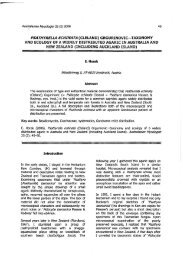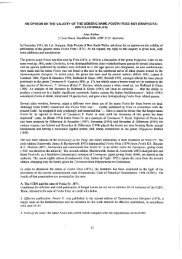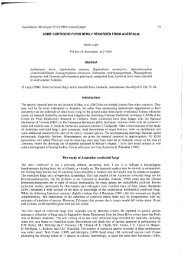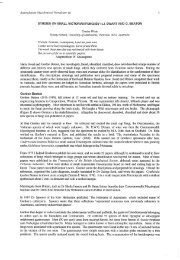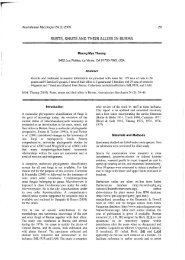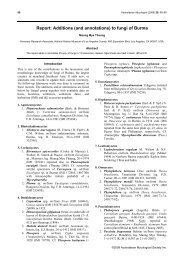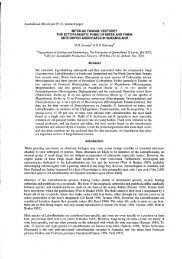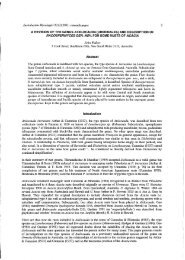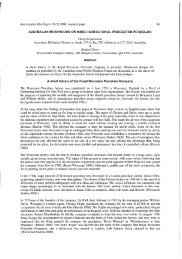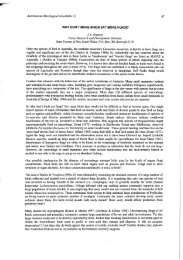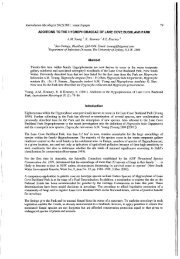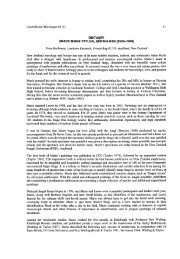close encounters with clathrus ruber, the latticed stinkhorn
close encounters with clathrus ruber, the latticed stinkhorn
close encounters with clathrus ruber, the latticed stinkhorn
You also want an ePaper? Increase the reach of your titles
YUMPU automatically turns print PDFs into web optimized ePapers that Google loves.
CLOSE ENCOUNTERS WITH CLATHRUS RUBER, THE LATTICED STINKHORN<br />
Tjakko Stijve<br />
Sentier de Clies no 12, 1806 St Legier, Switzerland.<br />
The author narrates his <strong>encounters</strong> <strong>with</strong> Clathrus <strong>ruber</strong>., <strong>the</strong> <strong>latticed</strong> <strong>stinkhorn</strong>, a rare species in<br />
middle and nor<strong>the</strong>rn Europe. Considerable variation in <strong>the</strong> height of <strong>the</strong> carpophores was<br />
observed, ranging from a mere 8 cm for Spanish and French collections to more than 20 cm<br />
among <strong>the</strong> Clathri growing in a park at Ouchy (Lausanne) on Lake Geneva. Chemical<br />
investigation of collection from that site confirmed that Clathrus <strong>ruber</strong> accumulates manganese,<br />
just as o<strong>the</strong>r <strong>stinkhorn</strong>s do. In all probability, this metal plays a role in <strong>the</strong> biochemistry of <strong>the</strong><br />
fungus, notably in <strong>the</strong> enzymatic liquefaction of <strong>the</strong> gleba <strong>with</strong> simultaneous formation of<br />
odorous compounds. Clathrus eggs were subjected to multi-element analysis in which <strong>the</strong><br />
gelatinous outer layer, <strong>the</strong> embryonal receptaculum and gleba were separately investigated. The<br />
gelatinous layer proved most rich in potassium, calcium, manganese and iron. Calcium<br />
undoubtedly stabilises <strong>the</strong> polysaccharide gel protecting <strong>the</strong> embryonal carpophore from drying<br />
out during <strong>the</strong> growth of <strong>the</strong> egg. The superior concentrations of <strong>the</strong> o<strong>the</strong>r elements (compared<br />
<strong>with</strong> those in <strong>the</strong> developing carpophore) suggest a placenta-like function of <strong>the</strong> gelatinous layer.<br />
The significance of <strong>the</strong> various elements in <strong>the</strong> biology of Clathraceae, Hysterangiaceae and<br />
Phallaceae is briefly discussed.<br />
Clathrus <strong>ruber</strong> Micheli: Persoon is undoubtedly one of <strong>the</strong> most beautiful representatives of <strong>the</strong> large family of<br />
<strong>stinkhorn</strong>s and allies. It was already described by <strong>the</strong> 16th century mycologist Charles de l'Ecluse, better<br />
known as Carolus Clusius. In fact, in his large work on <strong>the</strong> fungus flora of Austria/Hungary, 'Fungus in<br />
Pannoniis observatorum', he gives a full description of <strong>the</strong> species as Fungus coralloeides cancellatus,<br />
complete <strong>with</strong> an illustration that is reproduced here. In all European literature Clathrus <strong>ruber</strong> is presented as<br />
a warmth-loving species that is ra<strong>the</strong>r common in countries surrounding <strong>the</strong> Mediterranean. It is virtually<br />
absent in Holland and <strong>the</strong> Scandinavian countries, rare in Germany and Switzerland, but, surprisingly, not<br />
uncommon in Britain, especially on <strong>the</strong> south coast.<br />
As a Dutch chemist <strong>with</strong> a keen interest in<br />
mycology, I published my first studies on <strong>the</strong><br />
'flavour' of <strong>the</strong> big <strong>stinkhorn</strong> {Phallus<br />
impudicus L.: Persoon) in <strong>the</strong> mid-sixties. At<br />
that time, I would have loved to extend my<br />
modest research to Clathrus, but alas, this<br />
species proved extremely rare in my country.<br />
From <strong>the</strong> literature I learned that it had been<br />
found in 1735 by <strong>the</strong> great Linnaeus (<strong>the</strong><br />
founding fa<strong>the</strong>r of <strong>the</strong> modern botanical<br />
nomenclatural system) along a road between<br />
Amsterdam and Haarlem. After that it had<br />
only been observed a few times in gardens and<br />
hothouses, presumably introduced <strong>with</strong> soil or<br />
leafmould. For a very long time I knew<br />
Clathrus only from pictures and photos {e.g.<br />
Calonge 1979) until I found it in a garden on<br />
<strong>the</strong> Spanish island of Mallorca. It formed a<br />
small colony <strong>the</strong>re, and <strong>the</strong> eggs had only <strong>the</strong><br />
size of a ping-pong ball. Of course, I was<br />
thrilled to watch those eggs burst, and see <strong>the</strong><br />
beautiful red receptacle emerge. This process<br />
took only a few hours.<br />
French authors describe <strong>the</strong> fruitbody as a<br />
'fenetre treillisee' (window <strong>with</strong> bars), which<br />
is about <strong>the</strong> translation of <strong>the</strong> Greek word Clathrus. English and American mycologists speak of a <strong>latticed</strong><br />
<strong>stinkhorn</strong>, which amounts to <strong>the</strong> same thing.
For those readers who are not familiar <strong>with</strong> <strong>the</strong> Clathrus, it may be useful to give a brief description. The egg<br />
of this particular mushroom can already be recognised by <strong>the</strong> network markings that become more pronounced<br />
during development. The wall of <strong>the</strong> egg consists of three layers, <strong>the</strong> inner and outer ones are thin, <strong>the</strong> middle<br />
is a thick gelatinous mass that protects <strong>the</strong> embryonal mushroom from drying out. This mass also contains <strong>the</strong><br />
minerals and chemical compounds necessary for <strong>the</strong> development of <strong>the</strong> <strong>stinkhorn</strong>. Upon eclosion <strong>the</strong> holes in<br />
<strong>the</strong> emerging lattice are still small, but <strong>the</strong>y rapidly grow bigger upon expansion of <strong>the</strong> receptacle. Finally, <strong>the</strong><br />
pink to coral red Clathrus stands upright, somewhat loosely connected to <strong>the</strong> remainders of <strong>the</strong> egg.<br />
Subsequently, <strong>the</strong> olive brown spore mass on <strong>the</strong> inner side of <strong>the</strong> receptacle starts liquefying, whereupon a<br />
particular fetid smell is produced, which readily attracts flies which feed on <strong>the</strong> sugar-containing mucus, thus<br />
assuring <strong>the</strong> dissemination of <strong>the</strong> spores. After about 24 hours <strong>the</strong> lattice structure collapses, but by this time<br />
<strong>the</strong> spore mass has been completely removed and <strong>the</strong> offensive smell greatly diminished.<br />
I observed that my Spanish collection had indeed a cadaverous smell, but it was not as strong as that produced<br />
by a mature Phallus impudicus. This was also <strong>the</strong> case <strong>with</strong> <strong>the</strong> Clathrus I found some years later in a<br />
neglected garden in <strong>the</strong> French town of Lyon. The owner of <strong>the</strong> garden had ra<strong>the</strong>r negative feelings about<br />
<strong>the</strong>se 'clathres en reseau'. He looked on <strong>with</strong> disgust, while I dug out a few eggs to take <strong>the</strong>m along, assuring<br />
me that it was dangerous even to touch those fungi. Indeed, Ramsbottom (1953) in his classic Mushrooms and<br />
Toadstools mentions that Clathrus has a bad reputation in France, e.g. people in Gascogne believe that—what<br />
<strong>the</strong>y call—<strong>the</strong> Cancru causes cancer when handled. If <strong>the</strong>y find one, <strong>the</strong>y bury it carefully and deep. In o<strong>the</strong>r<br />
French departments touching <strong>the</strong> Clathrus is supposed to give you eczema, or even convulsions! In Spain <strong>the</strong><br />
population does not love <strong>the</strong> Clathrus ei<strong>the</strong>r. Folknames like 'Gita de bruixa' (witches' egg ) and 'Crane'<br />
(cancer) speak volumes. Although in several countries eggs of Phallus impudicus are eaten and sometimes<br />
considered a delicacy, I have not found any information about culinary or medicinal use of Clathrus <strong>ruber</strong>.<br />
Burk (1979) reported C. <strong>ruber</strong> to be poisonous.<br />
My third encounter <strong>with</strong> this fungus took place in 1987 during a visit to <strong>the</strong> Barla Museum in Nice (south of<br />
France). Jean Baptiste Barla (1817-1890), a well-known mycologist, had not only written a voluminous guide<br />
to <strong>the</strong> fungi found in <strong>the</strong> Nice area, but had also made a series of most realistically looking wax models of <strong>the</strong><br />
Clathrus in all stages of development and <strong>with</strong> variously shaped receptacles. I noticed that <strong>the</strong>se models were<br />
far bigger than my collections of this particular mushroom, and I asked myself if this reflected reality. In 1988<br />
this question was positively answered when I found in <strong>the</strong> pare d'Elysee in Ouchy (Lausanne, Switzerland)<br />
some ghost eggs being as big as an average apple. At first I thought that <strong>the</strong>se were eggs of Phallus impudicus,<br />
which is a common species in this country. However, imagine my surprise and joy when one of those eggs—<br />
which I had taken home for fur<strong>the</strong>r study—produced after a while a most beautiful Clathrus\ The colour of <strong>the</strong><br />
lattice work was not as red as that of my earlier finds, but <strong>the</strong> receptacle measured not less than 5 inches which<br />
was twice as big as that observed in <strong>the</strong> Spanish and French collections.<br />
Finding Clathrus <strong>ruber</strong> in Ouchy can probably be explained by <strong>the</strong> almost Mediterranean climate <strong>the</strong>re. The<br />
park is situated on <strong>the</strong> side of Lake Geneva that receives most sunshine. Clearly, Clathrus must feel itself at<br />
home <strong>the</strong>re, since fur<strong>the</strong>r investigation at <strong>the</strong> site revealed two more colonies, which produced carpophores two<br />
to three times a year. The occurrence of Clathrus here is probably just a manifestation of what is called '<strong>the</strong><br />
advance of <strong>the</strong> <strong>stinkhorn</strong>s in Europe'. These highly specialised, non-mycorrhizal gasteromycetes are<br />
apparently not affected by environmental degradation. Svreck (1983) has pointed out that during <strong>the</strong> last 30<br />
years Phallus impudicus has been widely diffused, even to <strong>the</strong> south of Sweden , whereas in <strong>the</strong> beginning of<br />
<strong>the</strong> century it was a fairly rare mushroom <strong>the</strong>re. Clathrus <strong>ruber</strong> may also be conquering new territories.<br />
Indeed, about ten years ago, it was repeatedly reported in <strong>the</strong> Berlin area. Even more exotic <strong>stinkhorn</strong>s turn up<br />
<strong>with</strong> increasing frequency in Europe, e.g. Anthurus archeri (Berk.) E. Fischer (= Clathrus archeri (Berk.)<br />
Dring), <strong>the</strong> octopus <strong>stinkhorn</strong>, which was accidently brought into France by <strong>the</strong> Australian army during WWI.<br />
It is now already a common species in Ticino, <strong>the</strong> Italian-speaking part of Switzerland. Recently, it was even<br />
observed as far north as Holland.<br />
I learned from fur<strong>the</strong>r observations in Ouchy that <strong>the</strong> dimensions of <strong>the</strong> <strong>latticed</strong> <strong>stinkhorn</strong> are variable, but it<br />
was clear that Barla had not exaggerated when making his wax models. Late autumn 1993, at a temperature<br />
of 4°C, <strong>with</strong> a strong wind blowing, I found a colony that was really thriving: when approaching <strong>the</strong> park from<br />
a 100 yards distance I saw a really enormous red receptacle. It was 8 inches high and 5 inches broad, and it<br />
was accompanied by half a dozen large eggs. Two of those, weighing 110 and 195 gms were taken along and<br />
put in a bin of garden soil under glass jars of respectively 0.6 and 1 litre (to avoid being surprised by <strong>the</strong> stench<br />
of <strong>the</strong> expanded carpophore). The skin of <strong>the</strong> biggest egg was already torn during <strong>the</strong> evening of <strong>the</strong> next day
showing <strong>the</strong> orange-red colour of <strong>the</strong> embryonal Clathrus. During <strong>the</strong> next 24 hours it emerged as a bulging<br />
sphere <strong>with</strong> holes, which permitted to see <strong>the</strong> olive-black gleba on <strong>the</strong> inside. The typical <strong>latticed</strong> form was<br />
only achieved on <strong>the</strong> 4th day: <strong>the</strong> 1 litre jar proved too small and was removed whereupon <strong>the</strong> receptacle<br />
proceeded to grow into a fine orange-red lantern, measuring 4x4x6 inches! Somewhat surprisingly, <strong>the</strong><br />
cadaverous odour proved weak enough to permit measuring and photographing <strong>the</strong> fungus, and to show it to<br />
interested persons. When placed outside, <strong>the</strong> smell still proved strong enough to attract flies, in spite of <strong>the</strong><br />
low temperature. After one day <strong>the</strong> lattice work collapsed, and was dried to be preserved as an herbarium<br />
collection. The o<strong>the</strong>r egg only opened after 8 days producing a pink receptacle of 2.8 x 3.3 x 4.5 inches, which<br />
was also too big for <strong>the</strong> glass jar covering it. The dimensions of <strong>the</strong> receptacles proved about proportional <strong>with</strong><br />
<strong>the</strong> weight of <strong>the</strong> eggs. This specimen also had a ra<strong>the</strong>r weak odour.<br />
Chemical investigations<br />
Stinkhorns are not only characterised by <strong>the</strong>ir peculiar Jack-in-<strong>the</strong>-box way of growth, but <strong>the</strong>y also have in<br />
common that, after eclosion, a number of chemical reactions are initiated to liquefy <strong>the</strong> gleba and produce <strong>the</strong><br />
cadaverous odour. Phallus impudicus has repeatedly been <strong>the</strong> subject of chemical investigations, which even<br />
resulted (during <strong>the</strong> 60s) in two doctoral <strong>the</strong>ses (Bindler 1967; Freund 1967). The German scientist Johannes<br />
Schmitt (1973) found that during eclosion of Phallus impudicus and Anthurus archeri a considerable amount<br />
of carbon dioxide gas is produced, simultaneously <strong>with</strong> <strong>the</strong> carrion-like stench. Carbon dioxide and <strong>the</strong><br />
'flavour' components (methyl sulfides, aldehydes and amines) are probably produced by enzymatic<br />
decarboxylation of keto- and amino acids, but such a process will work only in presence of certain metals, such<br />
as manganese. Now every "mushroom contains detectable amounts of this trace element, but in most gilled<br />
fungi, boletes and puffballs <strong>the</strong> concentration seldom exceeds 60 mg/kg on dry matter. Interestingly, Schmitt<br />
et al. (1977) found in a number of Hysterangia, and especially in <strong>stinkhorn</strong>s, exceptional high levels of<br />
manganese. The concentrations of this metal were even higher than those of <strong>the</strong> <strong>close</strong>ly related essential<br />
element iron (see Table 1).<br />
Table 1: Manganese and iron concentrations in Hysterangiales and Phallales<br />
(as reported by J. A. Schmitt et al. 1977)<br />
Species Manganese Iron • Ratio<br />
in mg/kg 111¾!!¾.':.;: 1 Fe: Mn<br />
Hysterangiales<br />
Hysterangium coriaceum 100 557 5.6<br />
Hysterangium stoloniferum 13-25 75-78 3.2-5.8<br />
Hysterangium nephriticum 14-46 393-702 15.3-28.1<br />
Hysterangium rubricatum LJ>25 116 0.5<br />
Hysterangium calcareum 18 295 16.4<br />
Gauteria otthii 10 138 13.8<br />
Phallogaster saccatus 448 135 0.3<br />
Phallales<br />
Clathrus <strong>ruber</strong> 447 573 1.3<br />
Anthurus archeri Egg 1956 226 0.1<br />
Receptacle 538 297 0.6<br />
Mutinus caninus Egg 230 335 1.5<br />
Phallus impudicus Egg 218 224 1.0<br />
Gelatinous layer 447 270 0.6<br />
Egg <strong>with</strong>out outer layer 168 132 0.8<br />
All values expressed on dry matter.<br />
These interesting results invite a number of comments. Among <strong>the</strong> Hysterangia <strong>the</strong>re are species <strong>with</strong> a low as<br />
well as a high manganese content. Some of <strong>the</strong>se subterranean gasteromycetes apparently exclude <strong>the</strong> element,<br />
since <strong>the</strong> soil contains on <strong>the</strong> average 1000 mg/kg (0.1%), whereas <strong>the</strong> iron content fluctuates between 1 and 6<br />
per cent. The above-ground growing Phallogaster saccatus A.P. Morgan, a rare fungus representing a bridge<br />
to <strong>the</strong> 'true' <strong>stinkhorn</strong>s and which contains, just as <strong>the</strong>m, more manganese than iron! Some of <strong>the</strong> <strong>stinkhorn</strong>s,<br />
e.g. A. archeri (bio) concentrates manganese, since its content, 2000 mg/kg, is higher than that of <strong>the</strong> average
soil. Our Clathrus <strong>ruber</strong> contains both much manganese and iron, but since Schmitt examined herbarium<br />
material, it is not clear what part of <strong>the</strong> fungus he analysed. The figures listed for <strong>the</strong> different parts of <strong>the</strong> big<br />
<strong>stinkhorn</strong> indicate that <strong>the</strong> outer part of <strong>the</strong> egg contains more manganese than <strong>the</strong> embryonal gleba! Such<br />
differences are also observed in <strong>the</strong> results for <strong>the</strong> various parts of A. archeri.<br />
To check <strong>the</strong>se interesting findings, we decided to analyse a few <strong>stinkhorn</strong>s in our own laboratory. For this<br />
purpose, comparative analyses of dried eggs of both Clathrus <strong>ruber</strong> and Phallus impudicus, as well as<br />
corresponding soil samples were carried out. Table 2 shows that both <strong>stinkhorn</strong>s prefer manganese. The much<br />
more abundant iron is only taken up in minor quantities. To study <strong>the</strong> distribution of <strong>the</strong>se metals and those of<br />
o<strong>the</strong>r essential elements in <strong>the</strong> different parts of Clathrus <strong>ruber</strong>, we ga<strong>the</strong>red a number of eggs in July 1993 of<br />
<strong>the</strong> afore-mentioned colony in Ouchy. Half a dozen were cut in thin slices, whereupon we isolated <strong>with</strong> a<br />
sharp knife <strong>the</strong> reddish embryonal receptacle and its blackgreen gleba, and dried <strong>the</strong>se parts overnight<br />
separately in a draft oven set at 55°C. The remaining gelatinous layer and its adhering skin were treated in <strong>the</strong><br />
same way. Subsequently, <strong>the</strong> dried parts were ground to a fine powder, sieved and stored in glass vials until<br />
carrying out <strong>the</strong> multi-element analyses of which <strong>the</strong> results are given in Table 3.<br />
Table 2: Manganese and iron concentrations in dried eggs of two Phallales species compared <strong>with</strong> soil<br />
levels<br />
Manganese mg/kg Iron mg/kg<br />
Phallus impudicus<br />
725-1118 108-143<br />
from la Foret de Jorat, Lausanne, CH<br />
Soil samples 430-1220 24000-36000<br />
Clathrus <strong>ruber</strong><br />
from <strong>the</strong> Pare d'Elysee, Ouchy, CH<br />
450-1900 180-570<br />
Soil samples 650-1250 13500-50000<br />
All values expressed on dry matter.<br />
Table 3: Essential chemical elements in Clathrus <strong>ruber</strong><br />
:<br />
;;.cf§,;,'<br />
; :<br />
!ppl>;| gpl-f •::/.:;<br />
K'a mg/kg :<br />
Cu<br />
mg/kg :;<br />
Smg/kg :1: mg/kg ..,: mg/kg<br />
Whole eggs after<br />
drying & grinding<br />
170 4.03 0.72 1137 1953 13 488 229 20<br />
Gelatinous layer and<br />
outer skin<br />
413 8.65 0.51 3490 2045 37 1454 261 17<br />
Receptaculum 431 5.62 0.82 289 2230 20 621 97 22<br />
Spore mass 223 2.84 0.62 111 2094 23 236 127 26<br />
All values expressed on dry matter.<br />
The concentrations listed for <strong>the</strong> various elements should not be taken too absolutely, since we analysed<br />
biological material, subject to considerable variation. However, <strong>the</strong> high levels of potassium, calcium,<br />
manganese and iron in <strong>the</strong> gelatinous layer are striking. These are undoubtedly those elements that are most<br />
essential to <strong>the</strong> fungus. Potassium is a component of <strong>the</strong> cells regulating <strong>the</strong>ir osmotic pressure. It is foremost<br />
necessary for <strong>the</strong> growth of <strong>the</strong> carpophore. There is not only a correlation between <strong>the</strong> potassium<br />
concentration and <strong>the</strong> water content of <strong>the</strong> fungi, but also <strong>the</strong> velocity of growth depends on <strong>the</strong> metal. The<br />
slowly growing polypores contain seldom more than 2 per cent potassium, but in <strong>the</strong> rapidly growing<br />
Coprinaceae 10 to 12 per cent is found (Stijve 1996). The gelatinous layer contains 8.65 per cent. It is<br />
<strong>the</strong>refore not unthinkable that <strong>the</strong> receptacle obtains its potassium from this source.<br />
The calcium concentration of 3490 mg/kg is much higher than that reported in literature for gilled fungi and<br />
puffballs (Seeger & Hiittner 1981). Calcium plays a role in <strong>the</strong> metabolism of <strong>the</strong> mushroom, stabilising<br />
intercellular membranes. In our Clathrus calcium undoubtedly stabilises <strong>the</strong> gelatinous layer which protects<br />
<strong>the</strong> embryonal carpophore during <strong>the</strong> growth of <strong>the</strong> egg, which takes between 2-4 weeks for its full<br />
development. The concentrations in <strong>the</strong> receptacle and gleba are ra<strong>the</strong>r modest. It has been established<br />
(Bindler 1967) that <strong>the</strong> gelatinous layer consists of polysaccharides just as <strong>the</strong> vegetable gums that are used as<br />
thickeners in <strong>the</strong> food industry. Indeed, <strong>the</strong> slimy part of <strong>the</strong> egg has characteristics similar to those of alginic
acid and pectine that also need calcium to produce a gel. The amount of manganese in <strong>the</strong> gelatinous layer<br />
suggests again that this part plays <strong>the</strong> role of a reservoir, even as a placenta, because <strong>the</strong> receptacle as well as<br />
<strong>the</strong> gleba contain more than average concentrations of <strong>the</strong> metal. The level in <strong>the</strong> spore mass (236 mg/kg)<br />
suggests <strong>the</strong> presence of manganese-containing enzymes that produce <strong>the</strong> sugars and odorous compounds<br />
necessary to attract <strong>the</strong> flies. Although <strong>the</strong> ratio iron: manganese in Stinkhorns is smaller than 1, it cannot be<br />
said that <strong>the</strong>se fungi are poor in iron. In our Clathrus <strong>the</strong> amount in <strong>the</strong> gelatinous layer is well above <strong>the</strong><br />
average value of 158 mg/kg reported by Manfred Lupper (1988) who examined not less than 500 fungi. An<br />
antagonism between <strong>the</strong> two metals—as observed in animal metabolism—does not seem to exist in higher<br />
fungi. In all <strong>stinkhorn</strong>s analysed so far, manganese predominates, but <strong>the</strong> iron content is also appreciable.<br />
The o<strong>the</strong>r elements listed in Table 3 do not invite much comment. The sodium content is less than 1 per cent<br />
of <strong>the</strong> potassium concentration. It apparently does not play a role in <strong>the</strong> fungal metabolism. It is curious that<br />
<strong>the</strong> levels of zinc and copper are significantly lower than those measured in many o<strong>the</strong>r mushrooms (Mutsch et<br />
al. 1979). Perhaps <strong>the</strong> uptake of <strong>the</strong>se metals is inhibited in presence of much manganese. Magnesium is<br />
evenly distributed among <strong>the</strong> different parts of <strong>the</strong> Clathrus and its levels are in agreement <strong>with</strong> those reported<br />
in literature for o<strong>the</strong>r <strong>stinkhorn</strong>s (Seeger & Beckert 1979). The reader having some knowledge of biochemistry<br />
will not be surprised that <strong>the</strong> metals are accompanied by a considerable amount of phosphorus, just as is <strong>the</strong><br />
case in green plants. The element is largely present as phosphate (quantitatively <strong>the</strong> major anion) and it plays<br />
a key role in <strong>the</strong> transport of metals through <strong>the</strong> cell membranes. Of course, phosphate is also necessary for<br />
buffering <strong>the</strong> acid compounds formed during <strong>the</strong> metabolism of Clathrus.<br />
There is little doubt that <strong>the</strong> chemistry of Clathrus is interesting enough to be investigated more thoroughly.<br />
We know now that <strong>the</strong> mushroom takes up much manganese, but <strong>the</strong> supposed role of this metal in <strong>the</strong><br />
enzymatic reactions occurring during <strong>the</strong> liquefaction of <strong>the</strong> gleba has still to be elucidated. The isolation and<br />
characterisation of <strong>the</strong> manganese-containing enzymes would be a fine subject for a doctoral <strong>the</strong>sis, especially<br />
for a biochemist having an interest in mycology.<br />
References:<br />
Bindler, H.J. 1967. Untersuchungen an Pilzinhaltstoffen. Der Schleim des Hexeneies, Phallus impudicus L.<br />
Dissertation Marburg, Germany.<br />
Burk, W.R. 1979. Clathrus <strong>ruber</strong> in California and worldwide distributional records. Mycotaxon 8,463-468.<br />
Calonge, F.D. 1979. Setas (Hongos), Guia illustrada. Ed. Mundi-Prensa, Madrid, Spain, pp. 279-280.<br />
Freund, B. 1967. Die Geruchstoffe der Stinkmorchel, Ph. impudicus L. Dissertation Marburg, Germany.<br />
Lupper, M. 1988. Der Eisengehalt hoherer Pilze. Dissertation Wiirzburg, Germany.<br />
Ramsbottom, J. 1953. Mushrooms & Toadstools. A study of <strong>the</strong> activities offungi. Collins, London, U.K.<br />
187-188.<br />
Schmitt, J.A. 1973. Funde des Tintenfischpilzes, Anthurus archeri (Berk.) E. Fischer, im Saarland. Abhandl.<br />
Arbeitsgemeinschaft fur tier-undpflanzengeographische Heimatforschung im Saarland 4.<br />
Schmitt, J.A., Meisch, H.U. & Reinle, W. 1977. Schwermetalle in hoheren Pilzen, II: Mangan und Eisen.<br />
Zeitschrift fur Naturforschung, Section C, Biosciences 32c, 712-723.<br />
Seeger, R. & Beckert, M. 1979. Magnesium in Hoheren Pilzen. Zeitschrift fur Lebensmittel -Untersuchung<br />
und -Forschung 168, 264-28 \,<br />
Seeger, R. & Hiittner, W. 1981. Calcium in Pilzen. Deutsche Lebensmittel-Rundschau 77, 385-392.<br />
Stijve, T., 1996. Potassium content and growth rate of higher fungi. Australasian Mycological Newsletter 15,<br />
70-71.<br />
Svrcek, M., 1983. Dausien's Grosses Pilzbuch in Farbe. Verlag Werner Dausien, Hanau, Germany, p. 71.



